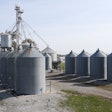Dr. Thomas Scott, research chair in feed processing technology, Department of Animal and Poultry Science, University of Saskatchewan, said that mycotoxin contamination of portions of the wheat crop in Canada this year is a problem, particularly fusarium and ergot contamination. He told the audience at Optivite’s Mycotoxin Seminar held at EuroTier in Hanover, Germany, that there is no silver bullet to detoxify contaminated grains or finished feeds, but there have been some advancements in technology which could help salvage some of the heavily mycotoxin contaminated wheat.
New research facility
For example, Scott said that the Canadian Feed Research Center, which opened on October 24, has a BoMill TriQ seed sorter which scans each individual kernel with light in the near-infrared range to find out characteristics that are important to food, malt or feed. These include crude protein, starch, moisture, grain hardness, and functional values.
Scott said that heavily mycotoxin-contaminated wheat or barley — so badly contaminated that it can’t be legally sold — can be sorted with this machine at a rate of 3 metric tons per hour to salvage about 80 percent of the original grain by recognizing the contaminated kernels and pulling them out. Scott said that the university is then using the contaminated fraction that is removed to produce test rations for use in mycotoxin research.
Dealing with mycotoxins
Scott said that the practice of mixing mycotoxin-contaminated grain with relatively mycotoxin-free grain is not a good solution. He also said that the test and reject approach to handling incoming ingredients isn’t the solution either, because the contamination frequently isn’t evenly distributed throughout the load of grain and it is easy to miss hot spots when sampling a truck, rail car or barge of grain. He said, you can’t find everything, and asked, “what happens to the contaminated feed that is rejected?” Another point that Scott made to bolster his point was that mycotoxin contamination can occur in storage in the grain silo or feed mill after purchase, and it doesn’t just happen on the farm. “Mycotoxins can occur pre-harvest, post-harvest and can get concentrated in storage,” he said.
Scott noted that washing, dehulling and polishing contaminated grain will reduce mycotoxin contamination on the outside of the kernel, but that it isn’t a total solution. He also said that ultraviolet radiation can work to decontaminate the surface of the kernel.
Scott said that certain mineral clays are absorbents that have positive and negative charges and can be used to bind some mycotoxins in vitro, but maybe not in vivo (inside the animal’s gut). He explained that detoxification of the mycotoxin in the gut of the chicken must happen quickly — within 30 minutes of the digesta becoming solubilized. He asked, “can we do this in dry feed some day?”
Yeast cell wall products can also be used to bind mycotoxins, Scott reported. He added that spray dried animal plasma works very well with young pigs to reduce the negative weight gain effect of mycotoxins, but he said it is an expensive treatment.
He said that at this time there is no one treatment for mycotoxin control that is a “silver bullet.” The solution needs to take a broad spectrum approach.


















